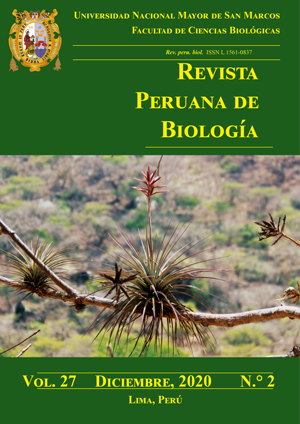Vertebrates road-killed in Tambogrande, Piura, Peru
DOI:
https://doi.org/10.15381/rpb.v27i2.16827Keywords:
Wildlife-vehicle collisions, Road ecology, Fauna mortality, Crossing structures, biodiversity, urban impact, roadsAbstract
Among the negative impacts on biodiversity caused by road works, such as road and highways, are the killed caused by collisions with vehicles. In this study, the mortality of amphibians, reptiles, birds and mammals by collision with vehicles is determined, on three roads that converge in the Tambogrande district (Piura in northern Peru), and the places with the highest incidence are established. Observations were between January and June of 2018 with a frequency of 24 trips once a week between the hours of 7.00 and 14.00. The trips were taken on a motorcycle at 25 km/h. Geographical coordinates of the point of collisions were recorded. The vertebrates mortality in transects lines was analyzed using the Kilometric Abundance Index (KAI). High incidence places were determined with a Kernel Density Analysis. 437 animals were found dead corresponding to 29 species. The animal group most affected was mammals followed by birds, reptiles and amphibians in that order. The mean KAI was 0.2 (95% CI 0.1 – 0.3) N° of incidences/km. We determinate 24 points of high incidence, they were close to each other. Based in our results, we propose to build eight animal crossing structures for vertebrates complemented with appropriate transit signals.
Downloads
Downloads
Published
Issue
Section
License
Copyright (c) 2020 Fabian Yesquen Sernaque, Armando Fortunato Ugaz Cherre, César Lautaro Chávez-Villavicencio

This work is licensed under a Creative Commons Attribution-NonCommercial-ShareAlike 4.0 International License.
AUTHORS RETAIN THEIR RIGHTS:
a. Authors retain their trade mark rights and patent, and also on any process or procedure described in the article.
b. Authors retain their right to share, copy, distribute, perform and publicly communicate their article (eg, to place their article in an institutional repository or publish it in a book), with an acknowledgment of its initial publication in the Revista Peruana de Biologia.
c. Authors retain theirs right to make a subsequent publication of their work, to use the article or any part thereof (eg a compilation of his papers, lecture notes, thesis, or a book), always indicating its initial publication in the Revista Peruana de Biologia (the originator of the work, journal, volume, number and date).






